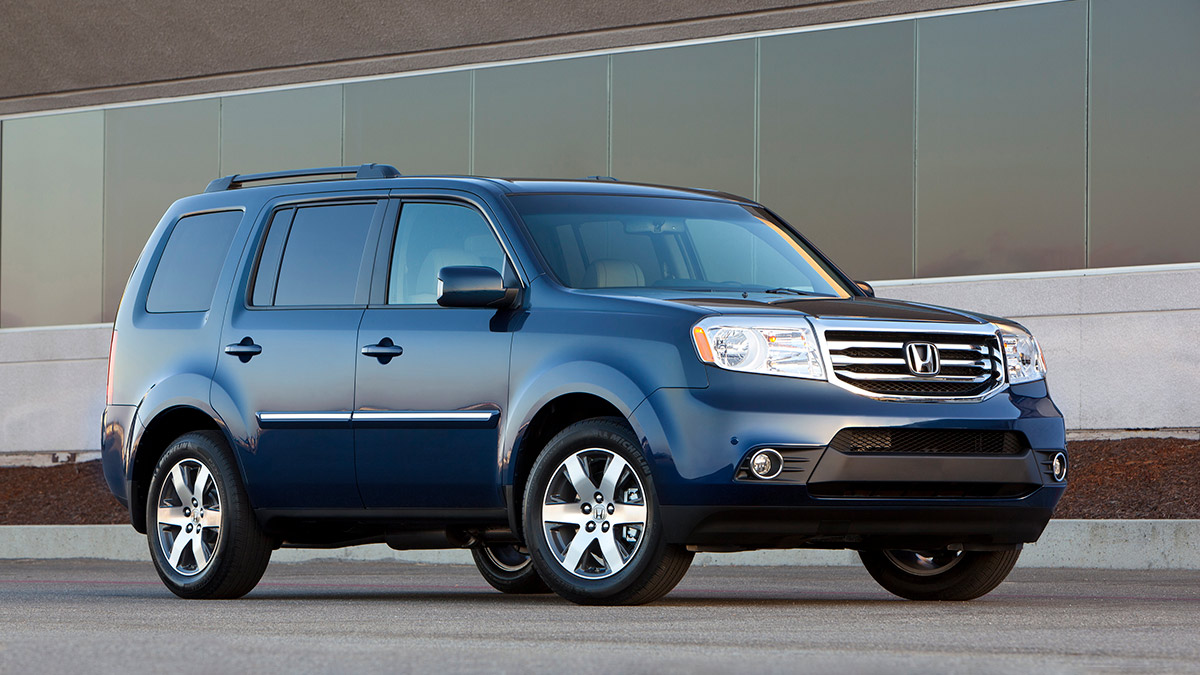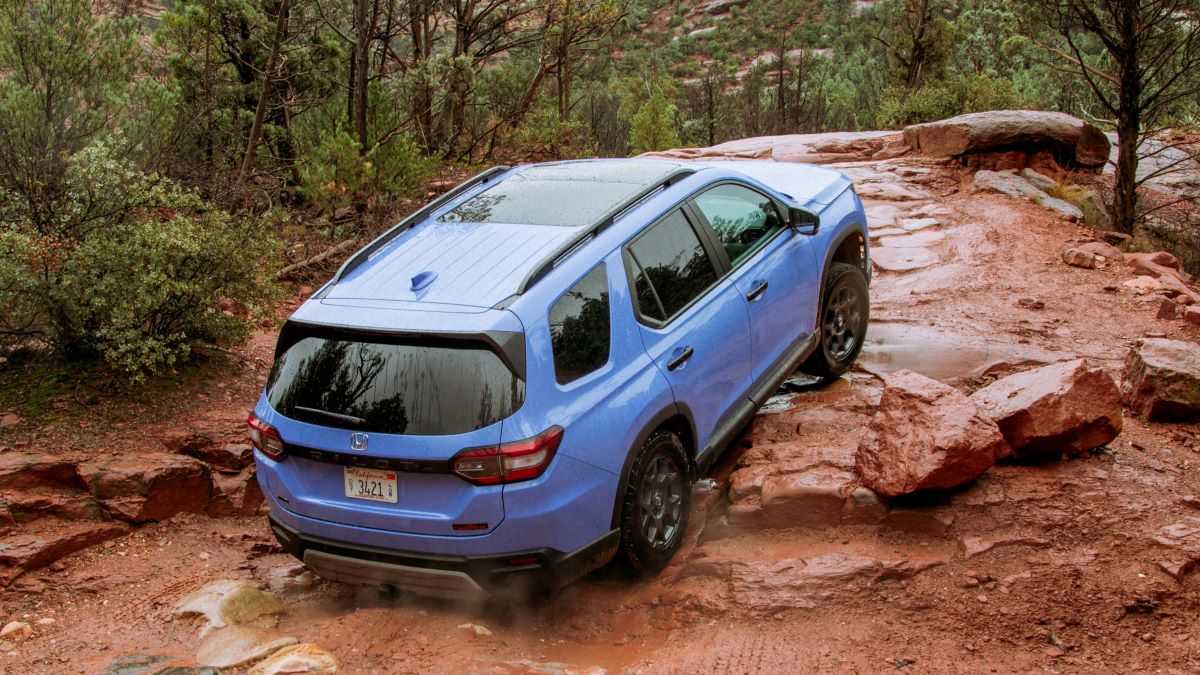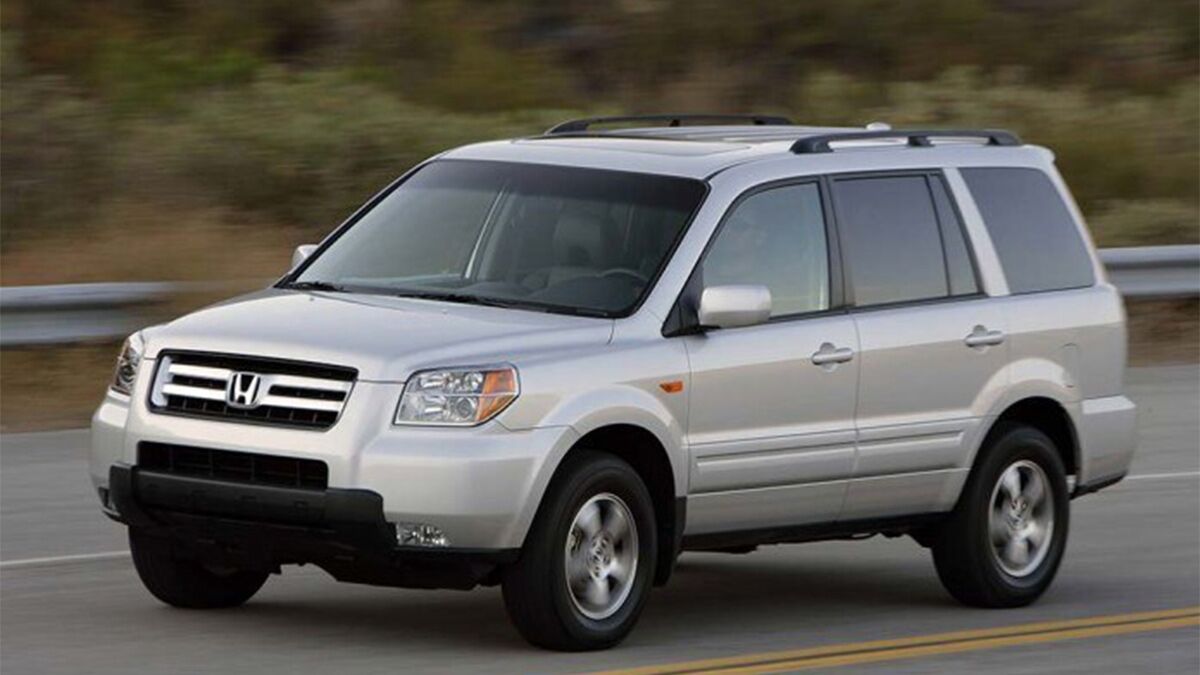
Used Honda Pilot Quick Facts
- We think used Honda Pilot models from 2009 to 2015 are the best buys here. For looks, space, and cutting-edge tech, the 2023 to current models are the best years for buying a used Honda Pilot.
- Holding its value through the years better than most competitors, a used Pilot tends to be more expensive than its contemporary rivals.
- Capable of seating up to eight, the Pilot is Honda’s largest SUV.
The Honda Pilot is a 3-row SUV that is big on safety, reliability, and style. Honda’s largest passenger vehicle is also well regarded in the used car field, which means finding a low-priced version in excellent condition can be a bit of a challenge. Sharing its platform with the Honda Accord and the upscale Acura MDX, the Pilot has sound roots. A potent V6 engine and fuel economy on par with others in the class are a bonus, but some early models lacked sufficient power for towing and hauling. We’ll tell you more.
- What Is the Best Model-Year Used Honda Pilot?
- Honda Pilot by Generation: Which Should You Buy?
- Is the Honda Pilot a Good SUV?
- Does the Honda Pilot Have a Hybrid Option?
- How Much Can the Honda Pilot Tow?
- What Are the Most Reliable Years for the Honda Pilot?
- What Are the Worst Years for the Honda Pilot?
What Is the Best Model-Year Used Honda Pilot?

As for looks, space, and cutting-edge technology, the fourth generation is by far the best yet. Overall, we think the second-generation 2009-2015 models are the best value here. They offer more room than the first-generation models but won’t be as expensive as the third- or fourth-generation Pilot. For those on a tight budget, the first-generation Pilot makes a fine choice. Just be sure to have a mechanic familiar with Honda cars go over it with a fine-tooth comb, with extra attention paid to the transmission and radiator.
One advantage of buying a more expensive third-generation or fourth-generation Pilot is the advanced driver-assist systems not offered on earlier models. We’d look for an EX or EX-L model, the L meaning leather, and only opt for all-wheel drive (AWD) if you live in places where it snows. Otherwise, front-wheel-drive (FWD) models get better fuel economy and have fewer moving parts to fix over time.
As the Pilot holds excellent resale values, you’ll have to use all your bargaining skills to make a good deal, but you’ll have the peace of mind knowing your used car will hold its value well over time. That’s a good thing when it comes time to sell.
See used Honda Pilot SUVs for sale near you.
Honda Pilot by Generation: Which Should You Buy?
Fourth Generation: 2023-Current

The 2023 model year rang in a fully redesigned Honda Pilot. A beefier, more rugged exterior wrapped around a more spacious interior set the stage for a much-improved 3-row SUV. A removable second-row center seat could be stored in the back, allowing the 8-passenger capacity to switch to 7-passenger on the fly. Honda also provided more third-row legroom. A new, quieter V6 engine and 10-speed automatic transmission enhanced performance. Front-wheel drive (FWD) is standard on most Pilot models, with all-wheel drive (AWD) available. Honda jettisoned the SE trim while reinstating the LX as the entry-level grade below Sport. Armed with tri-zone automatic climate control, adaptive cruise control, proximity keyless entry, and more, even the base LX is well-equipped. Apple CarPlay and Android Auto become wireless in all but the LX trim. An expanded group of standard advanced safety features helps the driver and crew stay safe. The Insurance Institute for Highway Safety (IIHS) named the 2023 Honda Pilot to its list of Top Safety Pick+ vehicles. Because of recent testing protocol changes, the 2024 and 2025 Pilot earned the second-highest IIHS Top Safety Pick award.
The TrailSport continues on as the Pilot grade offering the most off-road prowess. It features an inch more ground clearance, a specially tuned suspension, skid plates, standard all-wheel drive, and the TrailWatch camera system positioned around the Pilot.
The notable generational recalls have been for brake pedal and potential stalling issues, and have involved 2023, 2024, and 2025 models.
Model-Year Changes:
- 2025: The Black Edition rejoins the top of the lineup for this generation, and LX is deleted, making Sport the new base trim.
- 2024: The Sport trim is added to the range.
See 2023 to current Honda Pilot SUVs near you.
Third Generation: 2016-2022

The 2016 Pilot brought a whole new look to Honda’s family crossover with sleeker styling, better interior quality, more standard and available safety features, and a more powerful engine. Also new with this generation was the addition of the Elite trim, a fully loaded model that slotted above the Touring trim. A new 6-speed automatic transmission was offered on all but the Touring and Elite trims, which received a 9-speed unit. Perhaps the most crucial addition to the Pilot was the addition of the Honda Sensing package that included advanced driver-assist systems such as forward collision warning and emergency braking, lane-keeping assist, and adaptive cruise control. This option was offered on all but the base LX trim. Additional safety features include rear cross-traffic alert, lane-departure warning, and the LaneWatch passenger-side mirror camera.
Under the hood, the third-generation Pilot got a new 3.5-liter V6 with start/stop technology. This engine was good for 280 hp. A sophisticated all-wheel-drive system was offered, as well as an advanced traction management system for both front-wheel-drive and all-wheel-drive models with settings for snow, mud, and other surfaces. This system was standard on all but the LX trim. Standard features included 18-inch alloy wheels, push-button start, and a multi-angle rearview camera. Moving up to the EX brought fog lights, Honda LaneWatch, 3-zone air conditioning, a power driver’s seat, an 8-inch display audio screen, and a smart entry key fob.
The EX-L added leather seating and a power liftgate, while the Touring and Elite trim opened the door to such luxuries as a rear-seat entertainment system, a 540-watt premium audio system, and standard Honda Sensing. The Elite offered unique features such as a panoramic moonroof, a heated steering wheel, and heated second-row captain’s chair seating.
The third-generation Pilot performed well in all its crash tests, earning a 5-Star Overall Rating from National Highway Traffic Safety Administration (NHTSA) and a Top Safety Pick ranking from IIHS.
We’ve not heard any major complaints about this generation, although the 2016 model did have a few recalls, including one for improper welds on the fuel tank that may lead to a fuel leak. Also, a few models across all third-gen years were caught up in a recall for some faulty engine parts.
Model-Year Changes:
- 2022: The all-new TrailSport joins the lineup, while Sport trim replaces the LX.
- 2021: The 6-speed automatic transmission is deleted, equipping the whole range with the 9-speed transmission. A new Special Edition arrives to close out another generation.
- 2020: Pilot Black Edition based on the Elite debuts.
- 2019: Front and rear exteriors are refreshed, and the Honda Sensing suite becomes standard on all trims.
- 2018: No significant changes.
- 2017: Android Auto and Apple become standard on EX and higher trims.
See 2016-2022 Honda Pilot SUVs near you.
Second Generation: 2009-2015

The 2009 Pilot rolled out with some major improvements. The styling remained boxy and upright, but the edges were now rounded, with a more truck-like appearance. Interior volume increased, as did the rear-seat room, horsepower, and fuel economy. A rear flip-up hatch window was integrated into the rear liftgate, making it easier to load small or lightweight items, and the second-row seats were made to slide fore and aft, making it easier to gain access to the third row.
In 2009, the Pilot’s power came from a 250-hp 3.5-liter V6 with Honda’s VCM (Variable Cylinder Management), which was now offered on both front-wheel drive and 4-wheel-drive (4WD) models. Four trim levels were available: LX, EX, EX-L, and the new Touring. The Touring trim offered new features such as premium audio, navigation, tri-zone air conditioning, and a power liftgate. The EX trim got a cool rear backup camera built into the rearview mirror.
The second-generation Pilot remained a J.D. Power favorite and continued to score well in government and IIHS crash tests. Facing stiff competition from vehicles like the Ford Explorer, the Toyota Highlander, and the Chevrolet Traverse, the Honda Pilot needed to up its game. However, unlike many competitors, the Pilot continued to bundle its options into packages specific to certain trims, so people who wanted features like heated seats or navigation had to purchase the more expensive upper-level trims.
For the most part, the second-generation Pilot ran with very few complaints. Owners did gripe at times about the thick pillars that limited visibility, poor city fuel economy (16-18 mpg), and a sometimes choppy ride over rough pavement. Others found fault with a lack of options, such as no second-row captain’s chair seating or high-end name-brand audio, and interior styling was a bit dowdy. Another sore spot for owners was interior noise levels, mostly from the tires, that made casual conversation over the three rows a bit difficult.
Model-Year Changes:
- 2015: A new SE trim arrives, touting pewter gray alloy wheels, a power moonroof, and a rear-seat DVD entertainment system.
- 2014: No significant changes.
- 2013: Optional equipment from the 2012 refresh, such as Bluetooth, USB integration, a high-resolution 8-inch intelligent Multi-Information Display, automatic climate controls, and a rearview camera, becomes standard equipment on all trims.
- 2012: Receives minor refresh with revisions to the front grille, chrome trim, and wheel designs. EX and EX-L models gain an updated audio system with a 2-gigabyte CD library, Bluetooth, and audio streaming
- 2011: Voice-activated navigation is made available on the EX-L trim
- 2010: No significant changes.
See 2009-2015 Honda Pilot SUVs near you.
First Generation: 2003-2008

Considering its age, the first-generation Pilot is still a relatively desirable used SUV. Looking like an oversized Honda CR-V, the first Pilot was built on the same platform that spawned the Honda Accord sedan, Honda Odyssey minivan, and the Acura MDX luxury SUV. With its unibody chassis, powerful V6 engine, and standard all-wheel drive, the Pilot was light-years ahead of its competition in the areas of solidity, quality, and capability. Power came from a 240-hp 3.5-liter V6 shared with the MDX. The transmission was a 5-speed automatic.
In comparison to its competition, the Pilot was longer than the Toyota Highlander but shorter than the Ford Explorer. It was wider than all the vehicles in its class, which allowed Honda to create a massive cargo bay capable of fitting a 4-by-8 sheet of plywood with the seats folded flat. With the seats in place, the Pilot can fit up to eight people, although the third-row seat is really only suitable for kids.
The Honda Pilot Was Offered in 3 Trims
LX, EX, and EX-L comprised the trim lineup. Even the most basic Pilot LX included front and rear air conditioning, cruise control, power windows, and door locks, plus a tilt wheel, 16-inch steel wheels, and remote keyless entry. Moving up to the EX, a power driver’s seat, an AM/FM radio, and CD and cassette players, steering wheel touch controls, and alloy wheels were added.
The EX-L upgrade included leather seating, heated front seats, and an available navigation or DVD entertainment system (you couldn’t get both together). Models equipped with 4-wheel drive featured Honda’s advanced VTM-4 system, which included automatic engagement when detecting wheel slippage and a manual locking function for dealing with low-speed off-road situations. In government crash tests, the 2003-2008 Honda Pilot performed above average, earning a 5-Star crash rating and 4-Star rollover resistance rating.
For the most part, owners loved the first-generation Pilot. Some common issues for these years include transmission failure on the 2003-2004 models and radiator failure due to combining the transmission oil and engine cooling in the same core. Failure of the radiator would cause cross-contamination of the two fluids, leading to transmission issues.
Model-Year Changes:
- 2008: LX adds interior features and becomes Value Package or VP trim; new Special Edition (SE) adds amenities to the EX but doesn’t replace it.
- 2007: No significant changes.
- 2006: New front-wheel-drive-only model arrives; revised horsepower figure drops to 244; Variable Cylinder Management and Vehicle Stability Assist are standard
- 2005: Updated engine increases horsepower to 255 hp.
- 2004: Adjustable second tow; GPS navigation database updates
See 2003-2008 Honda Pilot SUVs near you.
Is the Honda Pilot a Good SUV?
We don’t think you can go wrong with a Honda Pilot, no matter the model year, if you do your research. It’s ideal for families and seats up to eight. Some are better maintained than others, which is an issue with any used vehicle.
Does the Honda Pilot Have a Hybrid Option?
No, the Honda Pilot does not yet offer a hybrid option; however, the company has said it plans to offer a system in the future.
How Much Can the Honda Pilot Tow?
It depends on the year and drivetrain. From 2003 to 2015, tow ratings for the 4WD or all-wheel-drive (AWD) models rate at 4,500 pounds for boat trailers but 3,500 pounds for other trailers; boats being more aerodynamic explains the increased capacity. Towing capacity for the new 2006 front-wheel-drive Pilot topped out at 3,500 pounds. The second-generation Pilot SUVs with front-wheel-drive reduce the towing capacity to 2,000 pounds without the optional transmission cooler; if properly equipped, the 3,500-pound limit is reinstated for the 2-wheel drive (2WD). Starting with the third and fourth generations, the 2-wheel-drive models top out at 3,500 pounds with the towing package, but the tow max increases to 5,000 pounds on the all-wheel versions.
What Are the Most Reliable Years for the Honda Pilot?
The Honda Pilot’s outstanding resale value speaks for itself. Honda, in general, and the Pilot, in particular, have better-than-average resale value. This only comes from reliable performance and relatively problem-free ownership. They aren’t perfect, but we would never hesitate to recommend the Pilot as a 3-row SUV. The fourth generation has the fewest recalls so far. For those shopping for a late-model Honda Pilot, try to find a certified pre-owned (CPO) SUV, as it will come with a detailed inspection and an extended warranty.
What Are the Worst Years for the Honda Pilot?
Pilot SUVs from the earlier years will be a bit more problematic because of some transmission issues. However, from the second generation on, the issues remain few and far between. Between 2003 and 2022, Honda issues several recalls related to its vehicles’ airbags, mostly regarding the inflators potentially exploding. It’s highly recommended that when shopping for a used Honda Pilot from those years, you check the SUV’s vehicle identification number (VIN) with NHTSA’s database to see if it was recalled and repaired, if so.
Editor’s Note: This article has been updated for accuracy since it was originally published.











how much avg, MPG does a honda piolt hold of gas